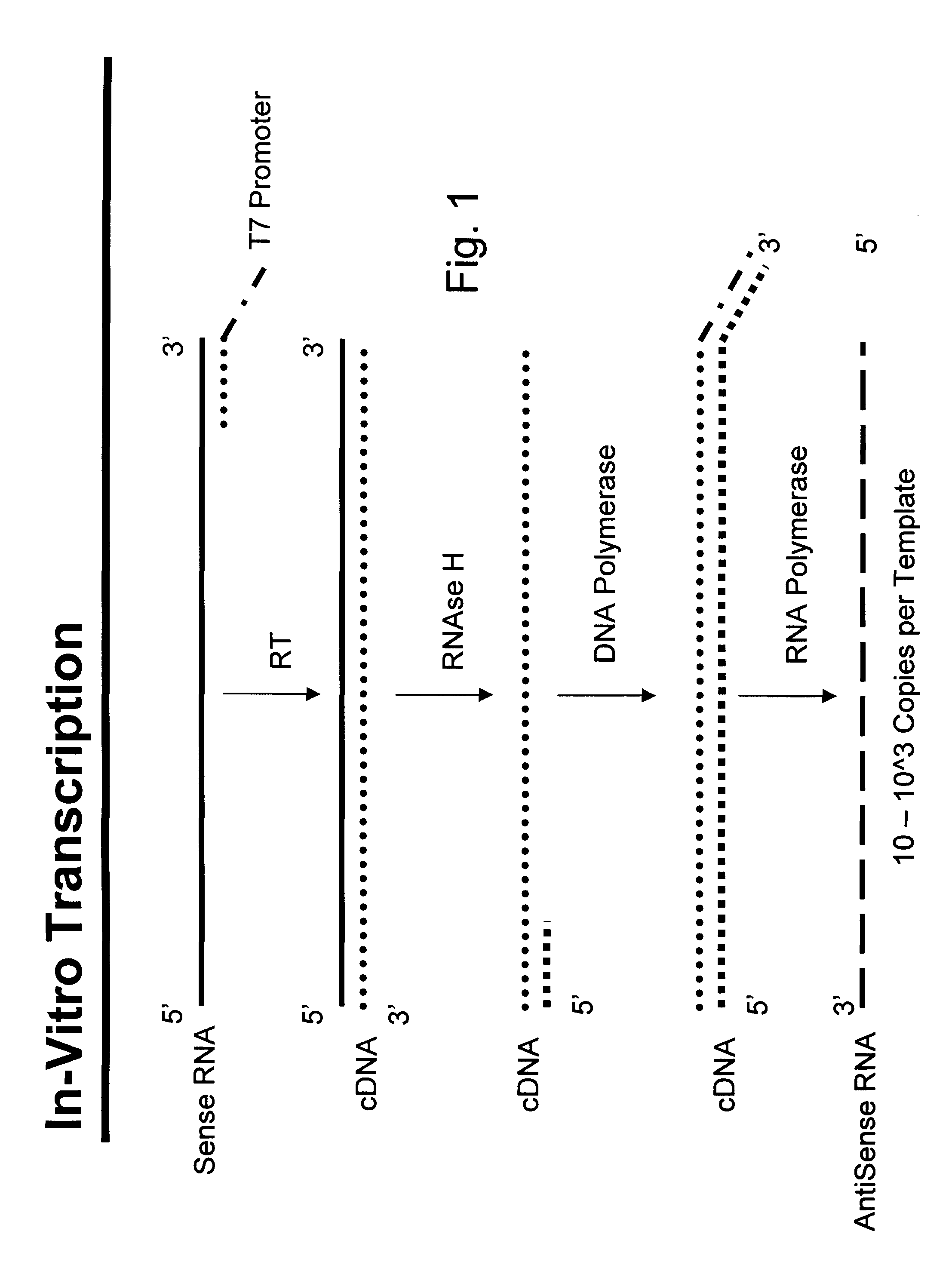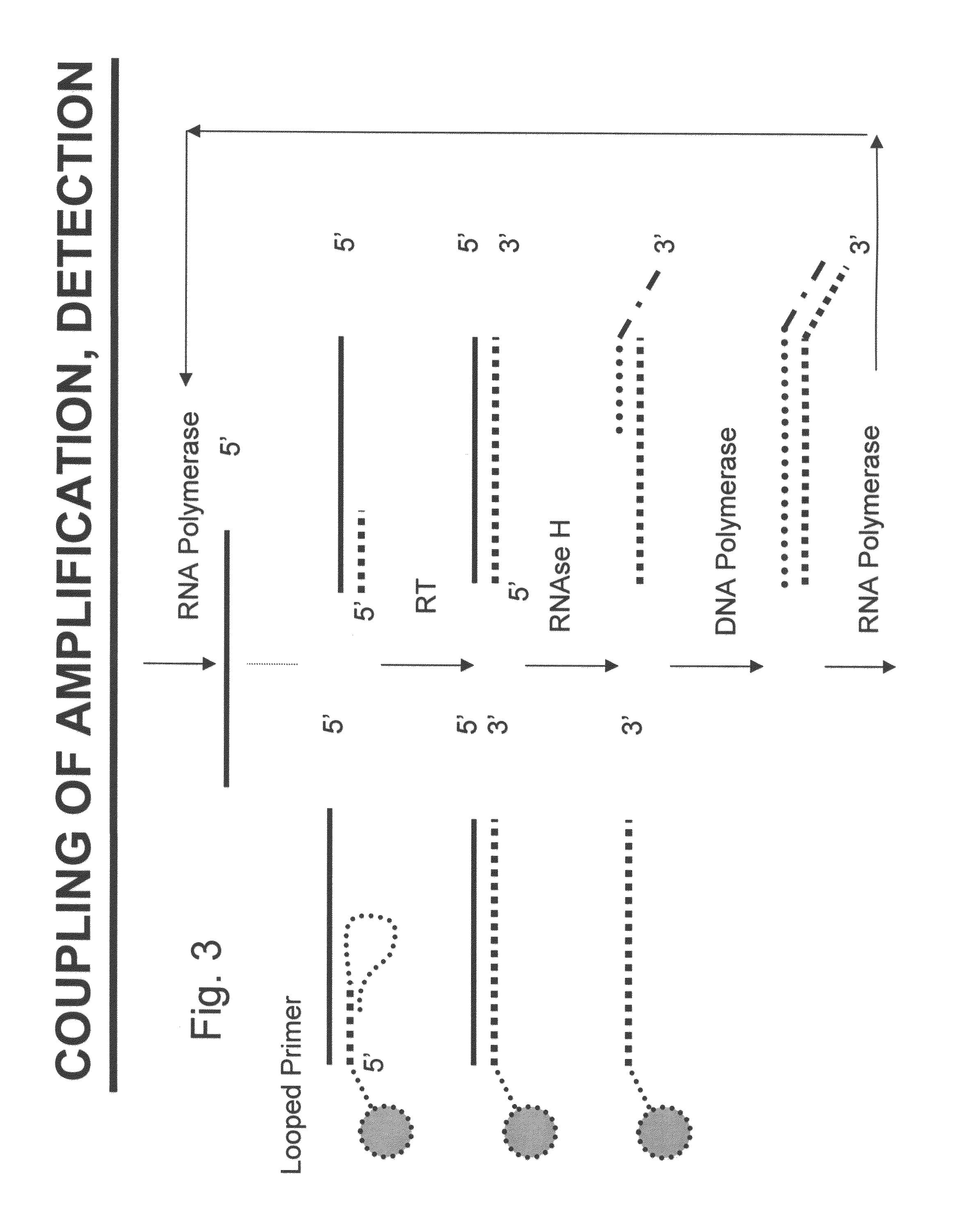Nucleic acid amplification with integrated multiplex detection
a technology of nucleic acid and multiplex detection, applied in the direction of fermentation, biochemistry apparatus and processes, microbiological testing/measurement, etc., can solve the problems of difficult multiplexing, significant evaporation, negative effect of assay conditions, etc., to reduce the number of target molecules, minimize sample handling, and enhance sensitivity
- Summary
- Abstract
- Description
- Claims
- Application Information
AI Technical Summary
Benefits of technology
Problems solved by technology
Method used
Image
Examples
example i
Integrating IVT and RT-eMAP in Different Formats
[0140]1.1 T7-Tagged dsDNA, IVT and RT-eMAP
[0141]Complementary RNA is synthesized in a separate (“uncoupled”) IVT reaction using T7 RNA polymerase and T7-tagged double-stranded DNA as a template which is in turn generated from human genomic DNA in a PCR reaction using T7-tagged reverse primer. Because the forward and reverse PCR primers are specific for exon 2 of the HLA-DQB locus, the cRNA contains the antisense sequence of the DQB locus. This provides the template for the RT-mediated elongation of degenerate oligonucleotide probes designed to act as sequence-specific RT primers which are attached to encoded beads.
[0142]Preparation of T7-tagged DNA templates for in vitro transcription—Exon 2 of the HLA-DQB1 locus was amplified in a PCR reaction using human genomic DNA as a template, a generic forward primer, and a reverse primer with a T7 promoter sequence at the 5′ end (FIG. 30A). Primer sequences are available at International Histoc...
example ii
Real-Time Detection in Homogeneous Format
[0156]In one of the assay formats described herein, the cDNA produced in the RT-eMAP reaction can be detected in real-time using fluorescently labeled “looped probes” (see, e.g., U.S. Provisional Application No. 60 / 628,464 “Probe Density Considerations and Elongation of Complementary Looped Probes Where Probes Are Attached to a Solid Phase” filed Nov. 16, 2004) or molecular beacons, containing a fluorescence donor at or near one terminus and a fluorescence acceptor at or near the other terminus. Looped probes or beacons are particularly preferable for real-time detection of RT-eMAP product in a homogeneous assay format comprising four steps as follows (see FIGS. 31 & 32):
[0157]Step 1: Sequence-Specific Capture.
[0158]Messenger RNA (mRNA) or cRNA is captured by annealing to a complementary oligonucleotide probe which has a complementary sequence and is attached to a color-encoded bead. The capture step can be carried out with oligonucelotide pr...
example iii
In-Well Homogeneous Beadchip Assay Using Looped Probes
[0168]BeadChips were prepared to contain a random planar array of ˜4,000 microparticles (“beads”) per BeadChip, wherein the beads are color-encoded with 36 distinguishable colors (as illustrated in the exemplary bead map of FIGS. 36 and 37)on a 375-μm thick silicon substrate (“silicon chip”). Bead staining and BeadChip assembly are disclosed U.S. application Ser. No. 10 / 348,165 (incorporated by reference). Each bead-type is functionalized with oligonucleotide probes of a particular sequence, which are attached to the bead surface prior to assembly of the BeadChips.
[0169]Magnetizable chips were constructed by sandwiching a small magnetizable strip (preferably formed from a perm-alloy material such as NiFe) between two regular chips such that the arrays on both sides face outward, and can contact the reaction buffer.
[0170]This experiment was designed to run a homogeneous IVT-RT-eMAP assay in one well of a microtiter plate, in a sin...
PUM
| Property | Measurement | Unit |
|---|---|---|
| volume | aaaaa | aaaaa |
| total reaction time | aaaaa | aaaaa |
| volume | aaaaa | aaaaa |
Abstract
Description
Claims
Application Information
 Login to View More
Login to View More - R&D
- Intellectual Property
- Life Sciences
- Materials
- Tech Scout
- Unparalleled Data Quality
- Higher Quality Content
- 60% Fewer Hallucinations
Browse by: Latest US Patents, China's latest patents, Technical Efficacy Thesaurus, Application Domain, Technology Topic, Popular Technical Reports.
© 2025 PatSnap. All rights reserved.Legal|Privacy policy|Modern Slavery Act Transparency Statement|Sitemap|About US| Contact US: help@patsnap.com



